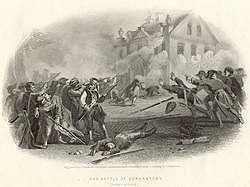Colonial Germantown Historic District | |
 | |
| Location | Both sides of Germantown Avenue, between Windrim Avenue and Sharpnack Street Philadelphia, Pennsylvania |
|---|---|
| Area | 113 acres (46 ha) |
| Built | 1683 |
| Architect | Multiple |
| Architectural style | Colonial, Georgian, Federal |
| NRHP reference No. | 66000678[1] |
| Significant dates | |
| Added to NRHP | June 23, 1965[2] |
| Designated NHLD | June 23, 1965[3] |
The Colonial Germantown Historic District is a designated National Historic Landmark District in the Germantown and Mount Airy neighborhoods of Philadelphia, Pennsylvania along both sides of Germantown Avenue. This road followed a Native American path from the Delaware River just north of Old City Philadelphia, through Germantown, about 6 miles northwest of Center City Philadelphia, and on to Pottstown. Settlement in the Germantown area began, at the invitation of William Penn, in 1683 by Nederlanders and Germans under the leadership of Francis Daniel Pastorius fleeing religious persecution.[2][4][5]
Colonial Germantown was a leader in religious thought, printing, and education. Important dates in Germantown's early history include:[6]
- August 16, 1683, Pastorius arrives in Philadelphia
- October 25, 1683, Lots are drawn for land among Pastorius's followers and settlement begins
- 1688, first American anti-slavery protest published
- 1690, first paper-mill built in America is built near Germantown
- 1705, possibly the first portrait painted in oil in America painted by Christopher Witt in Germantown
- 1708, first Mennonite Meetinghouse in America built in Germantown
- 1719, first Dunkards in America arrive in Germantown
- 1743, first Bible printed in America in any European language (in this case German), printed by Christoph Sauer
- 1760, Germantown Academy founded
- February 1764, the Paxton Boys enter Germantown but disperse after meeting with a delegation headed by Benjamin Franklin
- 1770, first American book on pedagogy written by Christopher Dock and published in Germantown
- October 4, 1777, Battle of Germantown
- 1793, during the Philadelphia Yellow Fever Epidemic, President Washington and his cabinet move to Germantown
- 1794, Washington spends two months in Germantown to avoid the heat in Philadelphia
- July 20, 1825, General Lafayette visits Germantown
- June 6, 1832, railroad from Philadelphia to Germantown opens
- ^ "National Register Information System". National Register of Historic Places. National Park Service. January 23, 2007.
- ^ a b Listing at the National Park Service Archived 2012-09-01 at the Wayback Machine
- ^ "Colonial Germantown Historic District". National Park Service. Archived from the original on September 1, 2012. Retrieved December 3, 2010.
- ^ NRHP 1966? Nomination Form Enter "public" for ID and "public" for password to access the site.
- ^ NRHP 1987? Nomination Form Enter "public" for ID and "public" for password to access the site.
- ^ Jenkins, Charles Francis (1902). The guide book to historic Germantown. Germantown: Site and relic society. p. 170. p. 7



